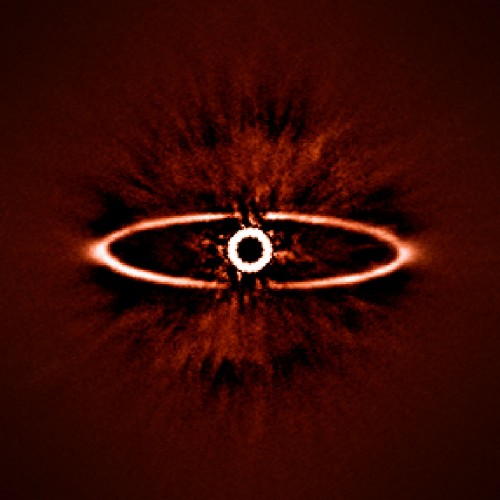
The dust ring around HR 4796A. (Courtesy: ESO/J-L Beuzit et al./SPHERE Consortium)
By Tushna Commissariat
While the fiery shades of the image above may seem familiar to fans of the Lord of the Rings movie franchise, pictured above in exquisite clarity is a ring of dust that surrounds the near-by star HR 4796A. The young, hot star – located a scant 240 light-years from Earth – has been of significant interest to astronomers since the circumstellar ring of debris was detected, thanks to an excess of infrared emissions from the star. While there have been many other images of the HR 4796A system, this particular image has been obtained by the new Spectro-Polarimetric High-contrast Exoplanet REsearch instrument (SPHERE), which was installed in May this year on the European Southern Observatory’s Very Large Telescope (VLT) at the Paranal Observatory in Chile. Thanks to the instrument, not only is the dust-ring clearly outlined, but the glare of the bright star at the centre of the picture has been supressed. This has provided a much clearer view of the whole system, which researchers think also harbours an exoplanet or two.
SPHERE’s main aim is to find and characterize giant exoplanets orbiting nearby stars, but by using direct imaging (most exoplanets are currently detected indirectly). This is a fairly daunting task, as most planets are easily missed thanks to their proximity to their much brighter and bigger parent stars. SPHERE’s entire design, therefore, is focused on reaching the highest contrast possible in a tiny patch of sky around a star. It exploits extreme adaptive optics to correct for the effects of the Earth’s atmosphere so that images are sharper and the contrast of the exoplanet increased. A coronagraph, used to block out the light from the star, increase the contrast still further. Finally, a technique called differential imaging, which exploits differences between planetary and stellar light in terms of its colour or polarization, is applied, thus helping scientists to directly image a currently invisible exoplanet.
Guidelines
Show/hide formatting guidelines
this text was deletedwhere people live in harmony with nature and animals</q>
Some text